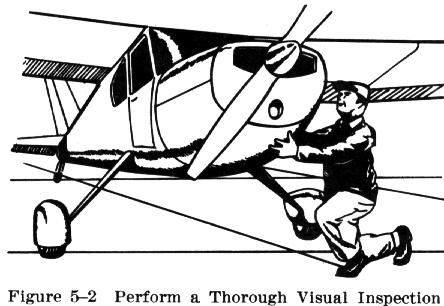Visual Inspection of the Airplane
Visual Inspection of the Airplane
To a pilot, the airworthiness of the airplane is both a
legal obligation and a direct responsibility. Careful personal attention
to preflight procedures is the mark of a safe pilot and will be repaid
not only in safety, but in lower airplane maintenance costs.
As the pilot approaches the airplane, the external visual
inspection should be started by looking for hazardous obstructions in the
parking area, and for dripping oil and fuel leaks under the airplane. Upon
reaching the airplane all tiedowns, control locks, and chocks should be
removed and the general appearance of the airplane checked for signs of
damage such as dents, cracks, or scratches. Then, the preflight inspection
should be performed in accordance with the printed checklist provided by
the airplane manufacturer (Fig. 5-2). |
 |
Water and dirt contamination in the airplane's fuel system
is potentially dangerous; therefore, the pilot should take certain actions
to prevent contamination or eliminate contamination that may have occurred.
If the airplane's weight and balance will not be adversely affected for
the next flight the fuel tanks should be completely filled after each flight,
or at least after the last flight of the day. The reason is that when air
in the fuel tanks cools, the moisture it contains condenses into water,
and contaminates the fuel. The more fuel there is in the tanks, the less
moist air the tanks will contain and the less condensation and contamination
will occur.
The pilot should always assume that the fuel in the airplane
may be contaminated with water, and take the necessary steps to eliminate
it during the preflight inspection. A substantial amount of fuel should
be drained from the fuel strainer (gascolator) quick drain and, if possible,
from each fuel tank sump into a transparent container to check for dirt
and water. Water will be noticeable since it will sink to the bottom of
the sample. Water (being heavier than gasoline), seeks the lowest levels
in the fuel system - that is where the fuel drains are located. If water
is found in the first sample, drain further samples until no trace appears.
A second preventive measure is to avoid refueling from
cans and drums, which may introduce fuel contamination by dirt or other
impurities.
Since each make and model of airplane has different features
to inspect, it is impractical to provide an appropriate checklist here.
Nonetheless, the following are some of the major items that should be given
particular attention during a preflight inspection:
1. Check landing gear control DOWN (if
retractable gear).
2. Turn master switch ON; check the
fuel quantity gauges.
3. Check master switch and ignition
switch OFF.
4. Visually check fuel supply in tanks;
secure the tank caps.
5. Drain fuel system sump (gascolator);
check for contamination.
7. Check that fuel system vents are
open.
8. Check oil level (ensure that dipstick
is properly seated).
9. Check for obvious fuel or oil leaks.
10. Check cowling and inspection covers
for security.
11. Check propeller and spinner for
defects or nicks.
12. Check tires for cuts, wear, and
proper inflation.
13. Check nose gear and landing gear
shock struts for proper inflation. Check wheel wells (if retractable gear).
14. Check hydraulic lines and landing
gear struts for leaks.
15. Inspect tailwheel spring, steering
arms, steering chains, and tire inflation (if tailwheel type).
16. Remove pitot tube cover, if installed,
and inspect pitot tube for clear opening.
17. Inspect static air source for clean
opening.
18. Ensure that wings and control surfaces
are free of mud, snow, ice, or frost.
19. Remove control surface lock, if
installed.
20. Check for damage and operational
interference of control surfaces or hinges.
21. Check landing flaps for signs of
operational interference.
22. Check windshield and cabin windows
for cleanliness.
23. Check carburetor air intake for
obstructions.
24. Check baggage for proper storage
and security.
25. Close and secure the baggage compartment
door.
